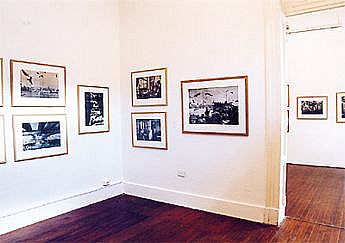|
Vistas de la muestra / Instalation views
| ||
|
Planta Baja / Ground Floor Entrada / Entrance Sala 1 / Room 1 Sala 2 / Room 2 Sala 3 / Room 3 Vista general de planta baja / General view of ground floor |
Primer Piso / First Floor Mesa de lectura / Reading Table Sala 5 / Room 5 Sala 9 / Room 9 Sala 10 / Room 10 |
|
|
Proyecto especial: Salgado en Buenos Aires
Special Project Salgado in Buenos Aires | ||
|
Plaza Italia 1 / Italia Park 1 Plaza Italia 2 / Italia Park 1 Obelisco 1 / Obelisc 1 Obelisco 2 / Obelisc 2 |
Parque Las Heras / Las Heras Park Barrio de Recoleta / Recoleta District |
|
SALAS 7-11
ASIA: EL NUEVO ROSTRO URBANO DEL MUNDO
La huída de la pobreza rural ha proporcionado a Asia un nuevo perfil urbano. Las ciudades se han convertido en imanes irresistibles para los campesinos del estado indio de Bihar, para los granjeros de la isla filipina de Mindanao, para los pescadores de Vietnam. Hipnotizados por la imagen que ofrece la televisión de la vida urbana, los emigrantes no suelen ser conscientes de las dificultades que les esperan. Y el éxodo continúa. De El Cairo a Shangai, de Estambul a Yakarta, de Bombay a Manila, esta emigración (ayudada por las altas tasas de natalidad) ha hecho surgir megalópolis del tamaño de São Paulo y Ciudad de México. Casi todas las ciudades más grandes del mundo se encuentran ya en Asia. Y la tendencia es irreversible: el rápido crecimiento económico de los años 80 y de gran parte de los 90 aceleró el crecimiento urbano, pero cuando la economía de los países asiaticos se colapsó brevemente a finales de la pasada década, ningún emigrante volvió a su tierra de origen.
En ningún lugar el cambio ha sido más repentino que en Shanghai: en apenas una década, las metrópolis del sur de China se han transformado hasta ser imposibles de reconocer. A pesar de sus rutilantes centros comerciales y edificios de oficinas, típicos de la nueva China, Shanghai aún no es capaz de proporcionar trabajo y vivienda apropiados a su población desbordante. En este sentido, es el típico ejemplo de gran ciudad asiática: una vida mejor para los que llegan sin nada es más una promesa que una realidad.
ROOMS 7-11
ASIA: THE NEW URBAN FACE OF THE WORLD
The escape of the rural poverty has provided to Asia a new urban profile. The cities have been converted in irresistible magnets for the peasants of the Indian state of Bihar, for the farmers of the Philipine island of Mindanao, for the fishermen of Vietnam. Hypnotized by the image of the urban life that offers the television, the migratorys do not tend to be conscious of the difficulties that them wait for them. And the exodus continues. From The Cairo to Shangai, from Istanbul to Yakarta, from Bombay to Manila, this emigration (helped by the high birthrate rates) has made temerge big cities of the size of São Paulo and Mexico City. Nearly all the largest cities of the world are found already in Asia. And the trend is irreversible: the rapid economic growth of the years 80 and of large part of 90 accelerated the urban growth, but when the economy of the asian countries has briefly collapse around the end of the past decade, no migratory returned to his land of origin.
In no place the change has been more sudden than in Shanghai: in almost a decade, the metropolis of the China south have been transformed until be impossible of recognizing. In spite of his sparkling commercial centers and office-supply buildings, typical of the new China, Shanghai it is not yet able of providing work and appropriate housing to his population. In this sense, it is the typical example of a great Asian city: a better life for those which arrive without nothing is more a promise than a reality.
